Energy Geography - Industrial Revolution
Introductions and background, Fundamentals of energy supply and demand, Energy balances and other data, Role of energy in development, Emergence of traded commodities, Global energy markets: balancing producers and consumers, Energy risks, Energy geopolitics and strategic considerations, Energy and sustainability, Possibilities in Africa, Southern Africa's role in delivering modern energy to Africa
Added on 2022-08-18
Energy Geography - Industrial Revolution
Introductions and background, Fundamentals of energy supply and demand, Energy balances and other data, Role of energy in development, Emergence of traded commodities, Global energy markets: balancing producers and consumers, Energy risks, Energy geopolitics and strategic considerations, Energy and sustainability, Possibilities in Africa, Southern Africa's role in delivering modern energy to Africa
Added on 2022-08-18
Energy in Industrial Revolution
Name
Institutional affiliation
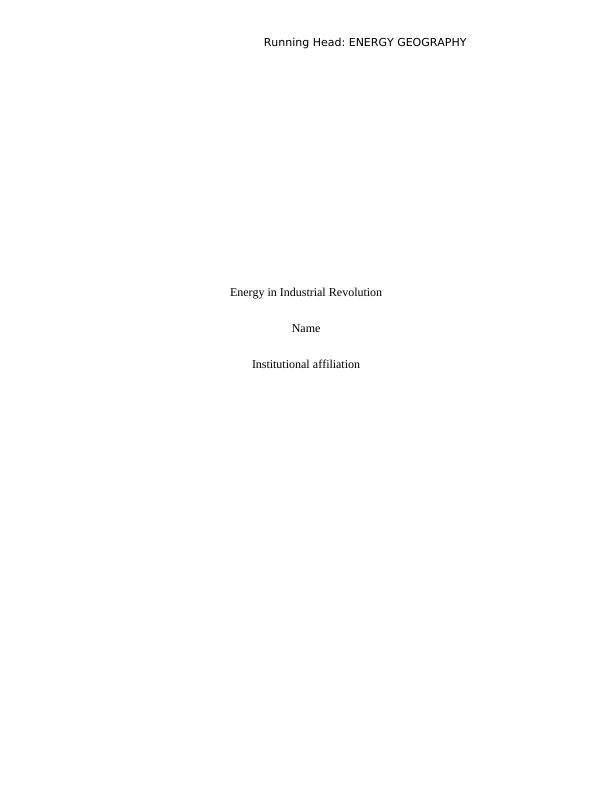
Contents
INTRODUCTION........................................................................................................... 3
OBJECTIVES................................................................................................................ 4
METHODOLOGY.......................................................................................................... 4
Case Studies............................................................................................................ 4
Secondary Sources.................................................................................................. 5
Case Study of the First Industrial Revolution in Britain........................................5
Case Study on Just Transition in South Africa.......................................................6
ANALYSIS.................................................................................................................... 7
Role of Energy in Industrial Revolution....................................................................7
The Just Transition................................................................................................... 9
Industrial Revolution and Just Transition...............................................................11
Just Transition in South Africa............................................................................... 12
Coal in South Africa............................................................................................ 12
Life After Coal.................................................................................................... 13
Employments..................................................................................................... 13
Regional Economic Developments.....................................................................14
Political Impacts................................................................................................. 15
Institutions for Just Transition............................................................................15
Just Transition in South Korea............................................................................... 16
Institutions for Just Transition............................................................................17
Policies............................................................................................................... 18
Comparison between South Africa and the Korean Republic Just Transition.........18
Alliances for Transition Management....................................................................19
CONCLUSION............................................................................................................ 20
RECOMMENDATION.................................................................................................. 21
REFERENCES............................................................................................................ 22
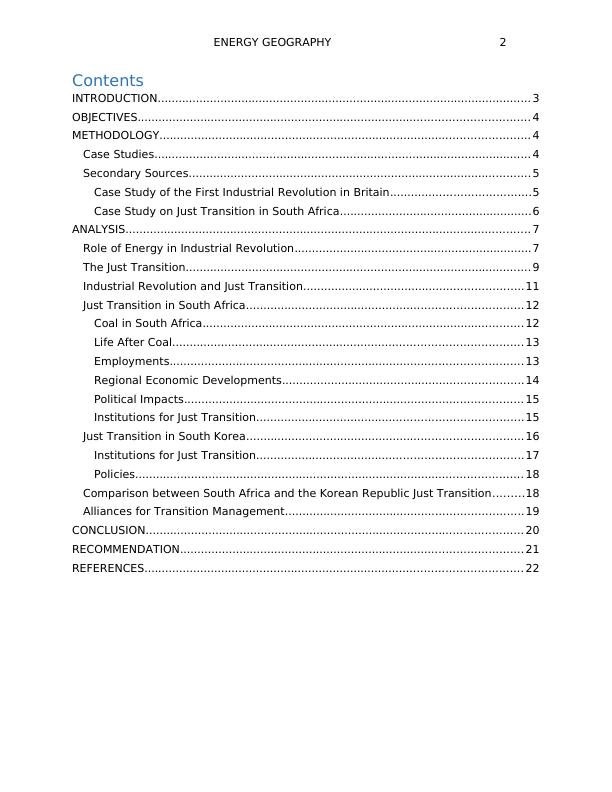
INTRODUCTION
This research paper discusses the role of energy in the industrial revolution and also just
transition in South Africa and South Korea. The research also compares just transition in South
Africa to another country and then suggests the alliances South Africa may develop to manage
the transition. The industrial revolution started in the 18th century when agricultural societies
became more urban and industrialized. Industrial revolution can be defined as the process of
change from handicraft an agrarian economy to one dominated by machine and industry
manufacturing (Tomory, 2016). This transition was characterized by the development of
machine tools, the rise of the mechanized factory system, the increasing use of water power and
steam power, new iron production, and chemical manufacturing processes, and also going to
machines from hand production methods.
The industrial revolution was majorly confined in Britain in the period 1760 and 1830. France
was less thoroughly and more slowly industrialized than either Belgium or Britain. The major
features of the industrial revolution were cultural, socioeconomic, and technological changes
(Humphries & Schneider, 2018). The changes in technology included an increase in
application of science in industry; Significant developments in communication and transportation
including radio, telegraph, airplane, automobile, steamship, and steam locomotive; a new
organization of work known as the factory system which entailed increased specialization and
division of labor; the invention of new machines like power loom and spinning jenny which
enabled production increase with minimal human energy expenditure; the use of new sources of
energy including both motive power and fuels like internal combustion engine, petroleum,
electricity, steam engine, and coal; and also the application of new basic material majorly steel
and iron (Breathnach, 2011).
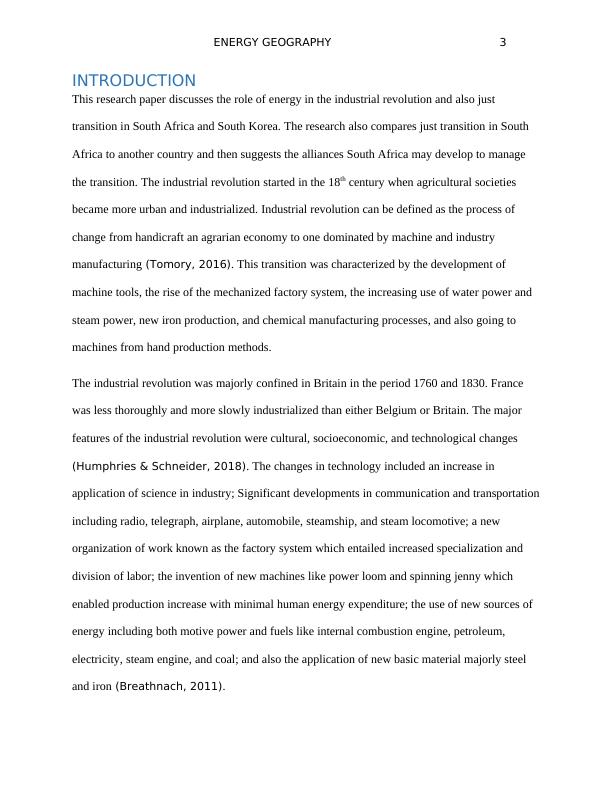
OBJECTIVES
The purpose and objectives of this research paper include:
To analyze the role of energy in the industrial revolution
To discuss just transition in South Africa and South Korea.
To compare just transition in South Africa to another country
To suggest the alliances South Africa may develop to manage the transition
METHODOLOGY
The sources of data adopted for this research on the role of energy in the industrial revolution
include secondary sources and case studies.
Case Studies
This research methodology involves a detailed, in-depth, and close scrutiny of a particular case
by following a formal method of research. The case study research method allows the
exploration and understanding of complex issues through reports of past studies. Through a case
study, it is possible to go beyond the quantitative statistical method and understand the behavior
conditions through the perspective of different people (Widdowson, 2011). The case studies
that would be examined in this research include the industrial revolution, use of energy in the
industrial revolution, application of industrial revolution to the just transition, and comparison of
the just transition in South Africa another company and then suggesting the alliances South
Africa may develop to manage transition (Tight, 2010). These case studies are likely to appear
in formal research venues as journals and professional conferences and not popular studies.
Case study research method involves multiple or single case studies, quantitative evidence,
benefits from prior theoretical proposition development and relies on different sources of
evidence. Case study assists in explaining both the outcome and process if the industrial
revolution through complete analysis, reconstruction, and observation. Case studies also in their

true essence, investigate and explore the role of energy in the industrial revolution in Britain
through detailed contextual analysis.
Secondary Sources
Secondary sources of data consist of information that has been collected and normally
interpreted by other researchers and then recorded in articles, books, and other publications. A
secondary source may include more data about the industrial revolution than primary sources.
These sources of information act as a way of keeping us with or discussing progress in the field
of study, wherein a researcher may use observations of another on a particular topic to
summarize his viewpoints on the industrial revolution (Pavlov, 2019). The secondary source of
information includes streaming video, newspaper articles, online journal articles, and books. The
secondary data are available readily from other sources hence there are no particular methods of
collection. The secondary sources of data can be both qualitative and quantitative. The
quantitative data can be acquired through transcripts, interviews, diaries, and newspapers.
Case Study of the First Industrial Revolution in Britain
The industrial revolution was confined largely to Britain in the period 1760 to 1830. The British
prohibited the exportation of manufacturing techniques, skilled workers, and machinery. The
monopoly of Britain could not last longer especially since some Britons saw some industrial
opportunities abroad that were profitable, while continental European businessmen sought to lure
the capability of the British to their countries (ALLEN, 2011). Two Englishmen, Joh Cockerill,
and William brought the industrial revolution to Belgium through the development of machine
shops in 1807. Belgium became the first country in the European continent to be economically
transformed (PARK, 2018). The government policies in England toward commerce and property
promoted the spread of global trade and innovation.
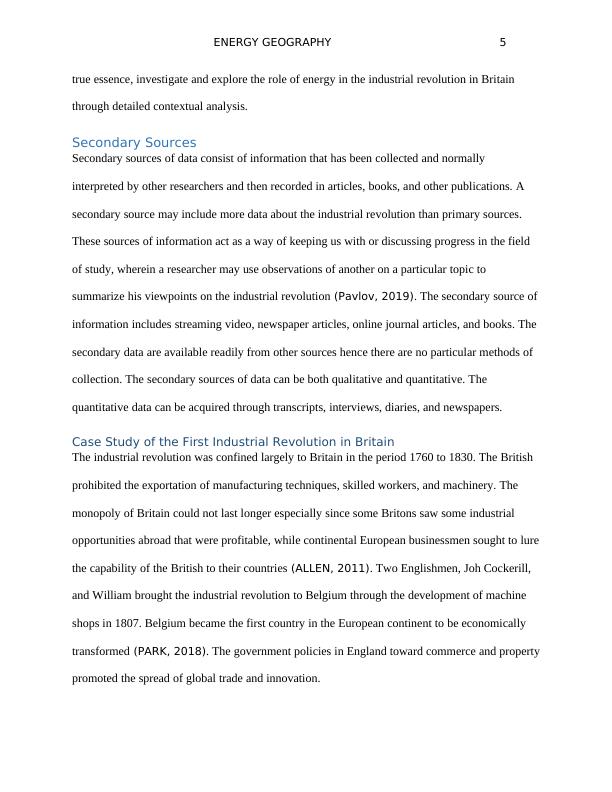
The government implemented patent laws that enabled investors to benefit financially from the
intellectual properties of their inventions. The coal and iron deposits were also abundant in Great
Britain and proved significant to the growth of all new machines made of steel or iron and coal
powered like the machinery and locomotive powered by steam (Tomory, 2016). As the
England population grew, more workers needed and were willing to buy textile goods. The
cottage industry showed how much individuals could produce in their homes through spinning
and weaving cloth by hand. However, this system of domestic production could not maintain the
increasing demands of the growing population of England. Various innovations shifted the
production of textile to a new system of factory.
Case Study on Just Transition in South Africa
Just transition is a framework developed by the movement of a trade union to include various
social interventions required to secure the livelihoods and rights of workers when economies are
shifting to sustainability in production, majorly protecting biodiversity and climate change. The
standards are set when setting climate goals for a clean economy (Widana, 2019). During the
process, sectors like forestry, agriculture, manufacturing, and energy which employ workers
must restructure. There were growing concerns that periods of structural economic change in the
past have left ordinary communities, families, and workers to bear the transition cost to the new
wealth production methods, resulting in exclusion for workers, poverty, and also unemployment.
A state-owned South African electricity utility known as Eskom announced the imminent closure
five of its power stations fired by coal in early 2017. The declaration sparked a strong reaction
from public debate and trade unions about how changes in the energy system of South Africa
will affect communities and workers (Balmer, 2017). There are policy mechanisms that
already exist in South Africa that could be used to reduce the negative impacts of a coal
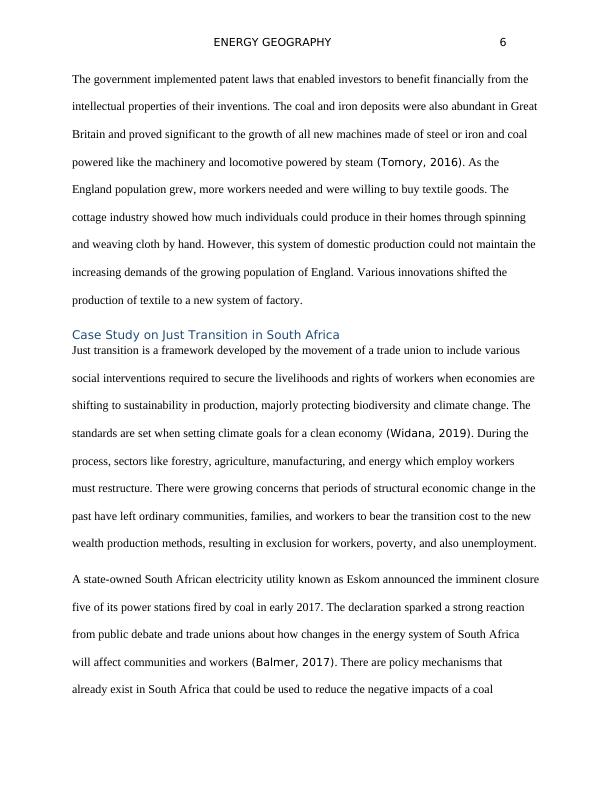
End of preview
Want to access all the pages? Upload your documents or become a member.
